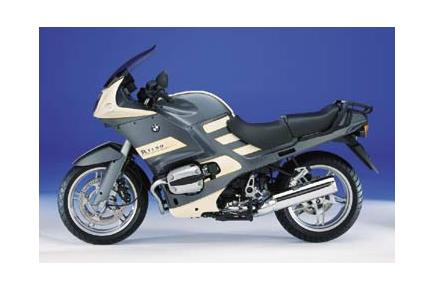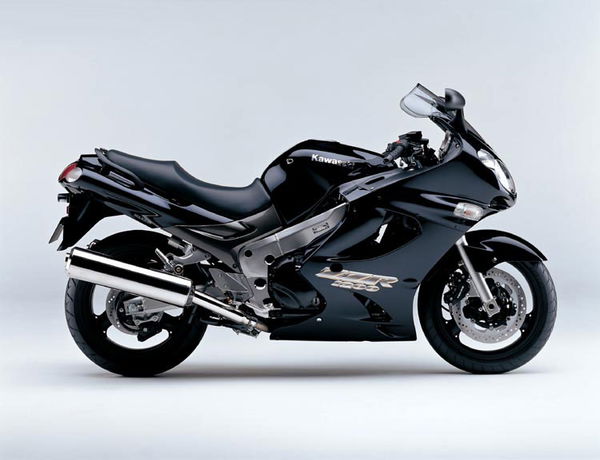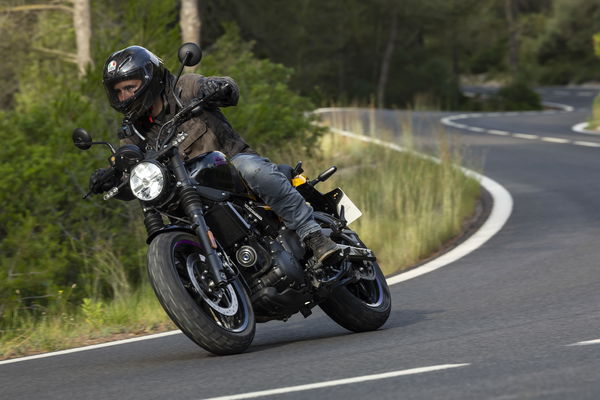R1150RS (2001 - 2005) review
Good bike, but could do with a style revamp and re-positioning in BMW’s range

In comes the latest development of the four-valve twin, boasting an extra 50cc and five bhp along with a catalytic converter and now a six – not five – speed gearbox. Brakes are also upgraded. You now get the EVO servo-assisted brakes and (as an optional extra) the BMW ABS system. New wheels (starfish alloys) replace the older three-spoke ones and you get a bigger screen. You don’t get much of a re-style, but as this is my first real experience of riding a BMW I’m quite looking forward to it.
The motor’s a raspy-sounding twin with a real bit of character. It makes good power from 4,000rpm through to a shade over 7,000 and the redline appears just 500rpm later. What impressed me was the smooth throttle response you get from the smallest amount of input from your right wrist, I just couldn’t fault it.
Top marks to BMW’s engine management system. It all results in a powerplant that’s very rideable and useable – just what you want from this sort of bike. Mind you, I couldn’t resist taking part in the traffic light GP and even with that degree of abuse I found the gearchange positive, albeit not too fond of clutchless changes, as a couple of times it jumped out of sixth into a false neutral.
The clutch is new for the 1150 and now hydraulic so maybe I should have used it a bit more often. The gear ratios are nicely spaced and will take you to a top speed of around 130, should you want it to. Whatever gear you’re in, 4,000 revs will do the trick, giving you useable, smooth power. And that seems to be the plus point with this Beemer. You’ve got a big twin motor down between your legs, but it’s so deceptively smooth.
Talking about what’s between your legs, the seat is comfy, as is the whole riding position. The seat does have the luxury of three positions… (a luxury I wish I had, if you know what I mean…) But along with the bar and peg position and the adjustable screen (which works well, but isn’t that different at any setting) you feel as though you can dominate the road in a big trailie style and stay dry at the same time.
So you’re comfy, but then you go for the indicators. I know it’s been said many times before, but what is it with BMW? Why do they persist with the switchgear arrangement? It’s confusing to me after the nice, normal road bike switchgear I’ve just gotten accustomed to.
One switch that was welcome on the bars was the heated grips. I thought heated grips were for ladies’ hair, but I soon saw the error of my ways. Despite the rain, I could switch the heated grips on and my hands were warm. How superb and how civilised! As a craggy old racer, I’m not used to such luxury. Wish I’d had them at Knockhill the other week!
Other sensible stuff is that the tacho and speedo fall easily to eye, and the rider’s information centre is useful, as it has fuel gauge, oil temperature, gear position, clock and trip meter. Mirrors are small, but don’t vibrate at all. Tank range was 155 miles before the light came on as I was doing some ‘brisk’ touring. So expect a range of 200 miles. In short, it all works.
Handling is pretty impressive, too. Try as I might I couldn’t scrape anything so everything seems well tucked away. Being a big ol’ bike, you need a bit of muscle to flick it about, mind. The Metzeler MEZs the bike wore performed well. I did a lot of fast road riding in the damp and never had a moment. I think, perhaps, they complemented that smooth throttle response from the engine.
Brakes performed well, too, although the new EVO set up – where you have servo assistance, lacks a little bit of feedback for the road. The ABS system though, is excellent and helps create a very stable machine under braking. I couldn’t get the thing to lock up once and believe me I tried, even with big old 17-stone snapper from Double Red, James Wright on the back…
Suspension and overall handling gives the RS the feeling that it’s something best used over smooth roads only. I hit a couple of potholes and it wasn’t pleasant. Personally, I reckoned the front Telelever is a little over-sprung and under-damped. Avoid bad surfaces, stick to smooth tarmac and it’ll handle as if on those proverbial rails. Sadly you can’t adjust the damping, but BMW insists it’s about right for the road.
Overall I liked the bike. A few little changes (like the indicators) would make it better still but, load it with luggage or a large pillion (sorry James) and it’ll still do the job without complaining. However, the RS seems to be a bit of an overlap with a few of the other models, such as the R1100S (will that be the next to get the 1150 engine?) and the excellent tourer the R1150RT. Still, you pays your money...
In comes the latest development of the four-valve twin, boasting an extra 50cc and five bhp along with a catalytic converter and now a six – not five – speed gearbox. Brakes are also upgraded. You now get the EVO servo-assisted brakes and (as an optional extra) the BMW ABS system. New wheels (starfish alloys) replace the older three-spoke ones and you get a bigger screen. You don’t get much of a re-style, but as this is my first real experience of riding a BMW I’m quite looking forward to it.
The motor’s a raspy-sounding twin with a real bit of character. It makes good power from 4,000rpm through to a shade over 7,000 and the redline appears just 500rpm later. What impressed me was the smooth throttle response you get from the smallest amount of input from your right wrist, I just couldn’t fault it.
Top marks to BMW’s engine management system. It all results in a powerplant that’s very rideable and useable – just what you want from this sort of bike. Mind you, I couldn’t resist taking part in the traffic light GP and even with that degree of abuse I found the gearchange positive, albeit not too fond of clutchless changes, as a couple of times it jumped out of sixth into a false neutral.
The clutch is new for the 1150 and now hydraulic so maybe I should have used it a bit more often. The gear ratios are nicely spaced and will take you to a top speed of around 130, should you want it to. Whatever gear you’re in, 4,000 revs will do the trick, giving you useable, smooth power. And that seems to be the plus point with this Beemer. You’ve got a big twin motor down between your legs, but it’s so deceptively smooth.
Talking about what’s between your legs, the seat is comfy, as is the whole riding position. The seat does have the luxury of three positions… (a luxury I wish I had, if you know what I mean…) But along with the bar and peg position and the adjustable screen (which works well, but isn’t that different at any setting) you feel as though you can dominate the road in a big trailie style and stay dry at the same time.
So you’re comfy, but then you go for the indicators. I know it’s been said many times before, but what is it with BMW? Why do they persist with the switchgear arrangement? It’s confusing to me after the nice, normal road bike switchgear I’ve just gotten accustomed to.
One switch that was welcome on the bars was the heated grips. I thought heated grips were for ladies’ hair, but I soon saw the error of my ways. Despite the rain, I could switch the heated grips on and my hands were warm. How superb and how civilised! As a craggy old racer, I’m not used to such luxury. Wish I’d had them at Knockhill the other week!
Other sensible stuff is that the tacho and speedo fall easily to eye, and the rider’s information centre is useful, as it has fuel gauge, oil temperature, gear position, clock and trip meter. Mirrors are small, but don’t vibrate at all. Tank range was 155 miles before the light came on as I was doing some ‘brisk’ touring. So expect a range of 200 miles. In short, it all works.
Handling is pretty impressive, too. Try as I might I couldn’t scrape anything so everything seems well tucked away. Being a big ol’ bike, you need a bit of muscle to flick it about, mind. The Metzeler MEZs the bike wore performed well. I did a lot of fast road riding in the damp and never had a moment. I think, perhaps, they complemented that smooth throttle response from the engine.
Brakes performed well, too, although the new EVO set up – where you have servo assistance, lacks a little bit of feedback for the road. The ABS system though, is excellent and helps create a very stable machine under braking. I couldn’t get the thing to lock up once and believe me I tried, even with big old 17-stone snapper from Double Red, James Wright on the back…
Suspension and overall handling gives the RS the feeling that it’s something best used over smooth roads only. I hit a couple of potholes and it wasn’t pleasant. Personally, I reckoned the front Telelever is a little over-sprung and under-damped. Avoid bad surfaces, stick to smooth tarmac and it’ll handle as if on those proverbial rails. Sadly you can’t adjust the damping, but BMW insists it’s about right for the road.
Overall I liked the bike. A few little changes (like the indicators) would make it better still but, load it with luggage or a large pillion (sorry James) and it’ll still do the job without complaining. However, the RS seems to be a bit of an overlap with a few of the other models, such as the R1100S (will that be the next to get the 1150 engine?) and the excellent tourer the R1150RT. Still, you pays your money...
| Length (mm) | 2170 |
| Width (mm) | 920 |
| Height (mm) | 1286 |
| Dryweight (kg) | 224 |
| Seats | 0 |
| Seat Height (mm) | 790 |
| Suspension Front | BMW Motorrad Telelever; stanchion diameter 35 mm, central strut, |
| Suspension Rear | Die-cast aluminium single-sided swinging arm with BMW Motorrad Paralever |
| Adjustability Front | Rebound damping adjustable |
| Adjustability Rear | Spring pre-load adjustable to continuously variable levels by means of hydraulic handwheel, rebound damping adjustable |
| Wheels Front | 3.50 x 17 |
| Wheels Rear | 5.00 x 17 |
| Tyres Front | 120/70 - ZR 17 |
| Tyres Rear | 170/60 - ZR 17 |
| Brakes Front | EVO-brake system with dual disc, floating brake di |
| Brakes Rear | Single disc brake, diameter 276 mm, double-piston |
| Tank Capacity (litres) | 22 |
| Chassis | Three-section composite frame consisting of front and rear section, load bearing engine. |
| Cubic Capacity (cc) | 1130 |
| Max Power (bhp) | 95 |
| Max Power Peak (rpm) | 7250 |
| Torque (ft/lb) | 74 |
| Torque Peak (rpm) | 5500 |
| Bore (mm) | 101 |
| Stroke (mm) | 70.5 |
| Valve Gear | Single cam |
| Compression Ratio | 11.3 |
| Valves Per Cylinder | 4 |
| Cooling | Air/oil cooled |
| Fuel Delivery | Electronic intake pipe injection |
| Stroke Type | Four Stroke |
| Drive | Shaft |
| Top Speed |











